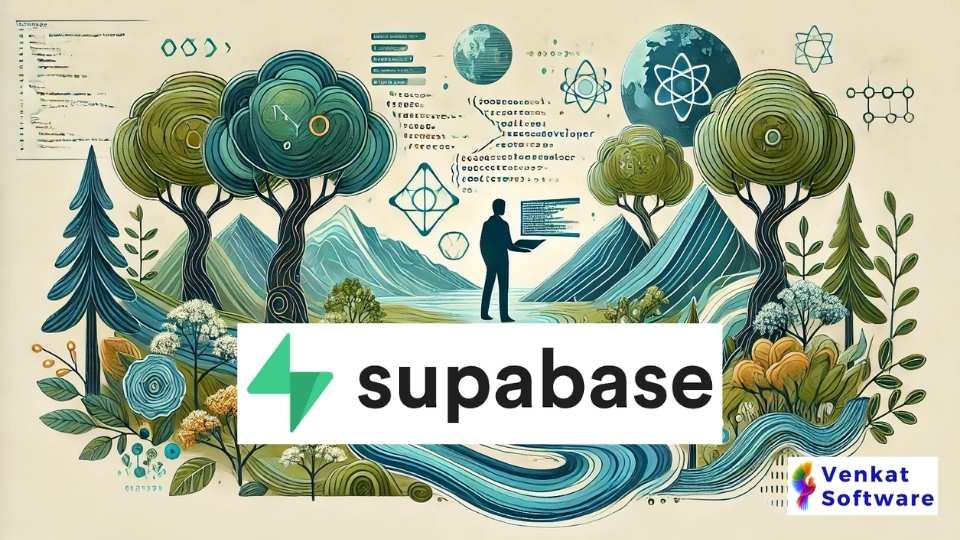Supabase: The Open-Source Firebase Alternative (A Complete Guide)
Supabase has quickly become a go-to platform for backend developers looking for a powerful, open-source alternative to Firebase. It integrates a robust PostgreSQL database with real-time functionality, authentication, storage, and serverless functions, providing a comprehensive backend solution.
Backend developers appreciate Supabase for its ease of use and flexibility, allowing them to implement relational databases, custom queries, and advanced security features without dealing with the complexities of traditional infrastructure. With its rapid updates and strong community, Supabase continues to evolve to meet developers’ modern needs.
Table of Contents
- Supabase: The Open-Source Firebase Alternative (A Complete Guide)
- What is Supabase?
- Key Features of Supabase (Updated for 2024)
- PostgreSQL Database
- Authentication
- Realtime Subscriptions
- Storage
- Edge Functions
- Auto-Generated APIs
- Supabase vs. Firebase: A Comparative Analysis (Updated for 2024)
- Getting Started with Supabase
- Setting Up a New Project
- Using the Supabase Dashboard
- Advantages of Using Supabase
- Open-Source Ecosystem
- SQL Database
- Ease of Integration
- Scalable and Performant
- Why Supabase?
What is Supabase?
Supabase is an open-source Backend-as-a-Service (BaaS) platform that provides a suite of tools to accelerate application development. Its key differentiation from Firebase lies in its use of PostgreSQL, a tried-and-tested relational database, combined with real-time updates, storage solutions, and authentication—all integrated in a developer-friendly platform.
Since its launch, Supabase has consistently rolled out new features, most recently culminating in Launch Week 12 in August 2024, which introduced several significant updates, including new AI-driven tools for working with PostgreSQL databases directly in the browser.
Key Highlights:
- AI-Enhanced SQL: Supabase’s
postgres.newallows users to interact with PostgreSQL databases through an AI interface. You can generate tables, import data, run migrations, and even perform vector-based searches. - Open-Source: As an open-source alternative to Firebase, developers can freely contribute to and extend the platform.
- PostgreSQL-Based: Offering the power and reliability of SQL for more complex data management and queries.
Key Features of Supabase (Updated for 2024)
Supabase continues to expand its feature set, offering an even more versatile toolkit for developers.
PostgreSQL Database
PostgreSQL is renowned for its reliability, feature robustness, and performance.
- Relational Data Modeling: Easily define relationships between tables.
- Advanced Queries: Leverage SQL for complex queries and data manipulation.
- Extensions Support: Utilize PostgreSQL extensions like PostGIS for geospatial queries.
At its core, Supabase is powered by PostgreSQL, giving you all the capabilities of a full-fledged SQL database. Recent improvements include enhanced Foreign Data Wrappers (FDW), allowing you to query external data sources like S3 and Stripe, and pg_replicate, which simplifies replication for distributed databases.
Authentication
Supabase provides a comprehensive authentication system out of the box.
- Multiple Providers: Supports email/password, OAuth (Google, GitHub, etc.), and third-party providers.
- Row-Level Security (RLS): Implement fine-grained access control directly at the database level.
- JWT Tokens: Uses JSON Web Tokens for secure authentication.
Supabase has upgraded its authentication module significantly in 2024. Not only does it support a variety of OAuth providers (Google, GitHub, etc.), but now developers can integrate external authentication providers like Auth0 and Firebase Auth directly into their Supabase projects, allowing more flexibility for those with existing infrastructure. Additionally, multi-factor authentication (MFA) has been expanded to include SMS and WhatsApp.
Realtime Subscriptions
Enable real-time functionality in your applications with minimal setup.
Scalable: Built using Elixir and Phoenix, ensuring high performance and scalability.
Realtime Updates: Subscribe to database changes and reflect them instantly in your app.
In addition to standard subscriptions, the platform now supports Broadcast and Presence Authorization, which allows fine-grained control over which clients can access real-time channels. This is especially useful for applications requiring private channels, such as multiplayer games or collaborative tools.
Storage
Manage file storage effortlessly with Supabase Storage.
- Object Storage: Store images, videos, and other files securely.
- Public and Private Buckets: Control access to your storage buckets.
- CDN Integration: Deliver content quickly via integrated Content Delivery Networks.
Supabase offers flexible file storage for images, videos, and other assets. The latest updates have increased the maximum upload size to 50GB for paid plans, making it easier to handle large files.
Edge Functions
Run serverless functions at the edge.
- Serverless Computing: Deploy functions without managing servers.
- Low Latency: Execute functions closer to the user for faster response times.
- Event-Driven: Trigger functions based on database events or HTTP requests.
Edge computing is becoming more critical for low-latency applications, and Supabase’s Edge Functions allow you to deploy serverless functions closer to your users. New in 2024 is enhanced logging via Log Drains, which allows you to export logs to third-party services like Datadog.
Auto-Generated APIs
- RESTful Endpoints: Interact with your database using RESTful APIs.
- GraphQL Support: Experimental support for GraphQL queries.
- Customizable: Modify and extend the APIs as needed.
Supabase automatically generates APIs for your PostgreSQL database, enabling quick access to your data via RESTful or GraphQL APIs. In 2024, aggregate functions such as sum(), avg(), and count() were added, improving the ability to perform group-based queries directly from your APIs.
Supabase vs. Firebase: A Comparative Analysis (Updated for 2024)
While Supabase and Firebase both serve similar purposes, the platforms have taken different approaches. Firebase remains a NoSQL solution with a proprietary, closed ecosystem, while Supabase emphasizes SQL-based data management and open-source flexibility.
| Feature | Supabase | Firebase |
|---|---|---|
| Database | PostgreSQL (SQL) | Firestore (NoSQL) |
| Open-Source | Yes | No |
| Realtime | Yes (Enhanced with Broadcast/Presence Authorization) | Yes |
| Authentication | Yes (OAuth, Firebase, Auth0, Cognito) | Yes |
| Storage | Yes (50GB upload limit) | Yes |
| Serverless Functions | Yes (Edge Functions) | Yes (Cloud Functions) |
| Pricing Model | Transparent, pay-as-you-go | Pay-as-you-go with free tier |
Key Differences:
- Database Type: Supabase’s PostgreSQL backend supports complex SQL queries and relational data models, whereas Firebase’s NoSQL Firestore offers more flexibility for unstructured data.
- Real-Time Updates: Supabase now offers fine-grained controls for real-time updates through the new Broadcast and Presence Authorization feature
- AI Integration: Supabase recently integrated AI tools to enhance database management, providing a powerful advantage for developers.
Getting Started with Supabase
Embarking on your journey with Supabase is straightforward. Here’s how to get up and running.
Setting Up a New Project
- Sign Up: Visit supabase.com and create a free account.
- Create a Project: Click on “New Project” in the dashboard.
- Configure Database: Provide a name, password, and select a region.
- Initialize: Wait for Supabase to provision your PostgreSQL database.
Using the Supabase Dashboard
The dashboard is your central hub for managing your Supabase project.
- Tables & Data: Create and manage database tables.
- Authentication: Set up authentication providers and policies.
- Storage: Manage your files and storage buckets.
- SQL Editor: Run SQL queries directly.
- API Documentation: Access auto-generated API docs specific to your project.
Advantages of Using Supabase
Open-Source Ecosystem
Being open-source, Supabase allows developers to:
- Customize: Modify the source code to fit specific needs.
- Contribute: Participate in the development and improvement of the platform.
- Transparency: Audit the codebase for security and reliability.
SQL Database
- Complex Queries: Utilize joins, subqueries, and other SQL features.
- Data Integrity: Enforce schemas, constraints, and relationships.
- Maturity: Benefit from decades of PostgreSQL development and optimization.
Ease of Integration
- SDKs: Available for JavaScript, Python, and more.
- Documentation: Comprehensive guides and API references.
- Community Support: Active forums and community contributions.
Scalable and Performant
- Horizontal Scaling: Scale out read replicas for high-traffic applications.
- Performance Optimization: Use indexes, caching, and other PostgreSQL performance features.
Why Supabase?
Supabase is rapidly evolving and solidifying its place as a leading Backend-as-a-Service (BaaS) platform. With continuous updates—most notably the integration of AI tools, advanced real-time capabilities, and external authentication support—Supabase offers a robust, open-source alternative to Firebase for developers seeking flexibility, control, and power.
As more features continue to roll out, including enhanced logging, AI-driven database management, and multi-environment setups, Supabase remains a top choice for developers building scalable, real-time applications. Whether you’re a startup or a large enterprise, Supabase’s SQL-powered backend provides the reliability, scalability, and transparency necessary to meet today’s application development demands.
Venkat

